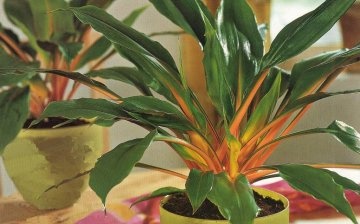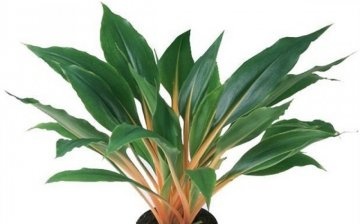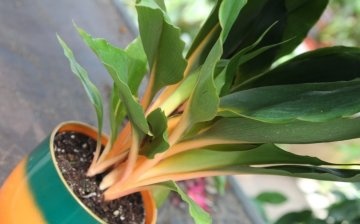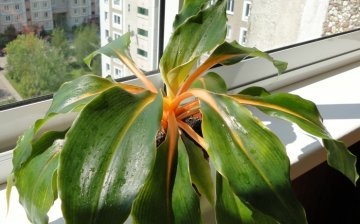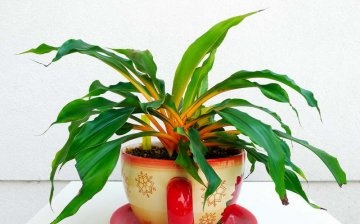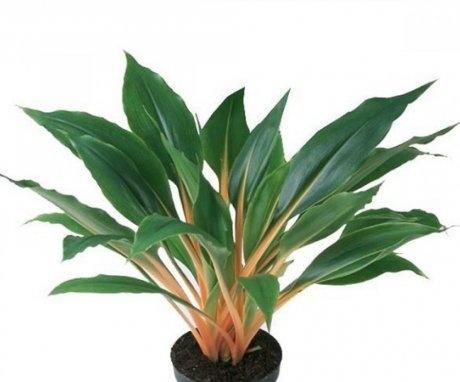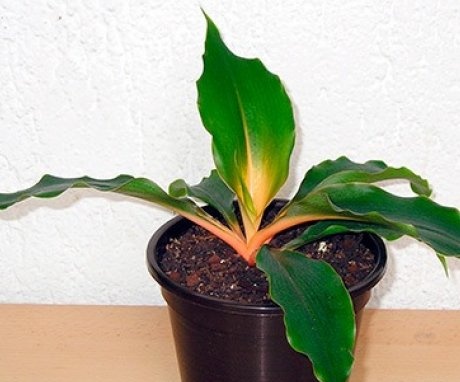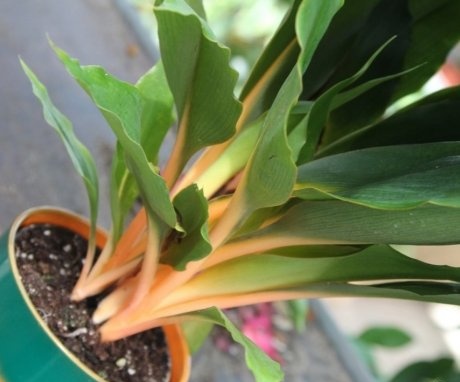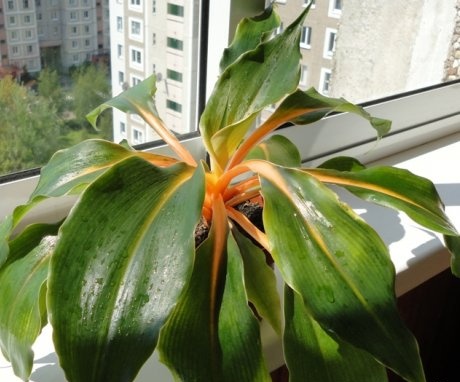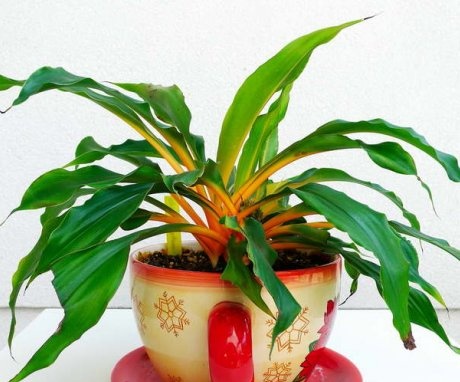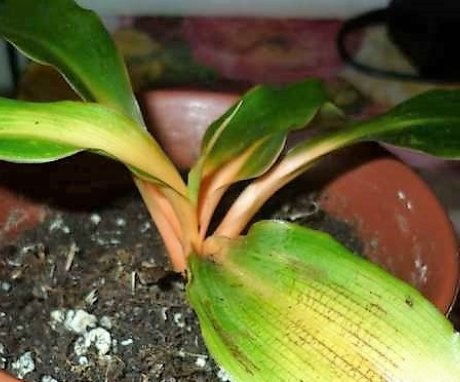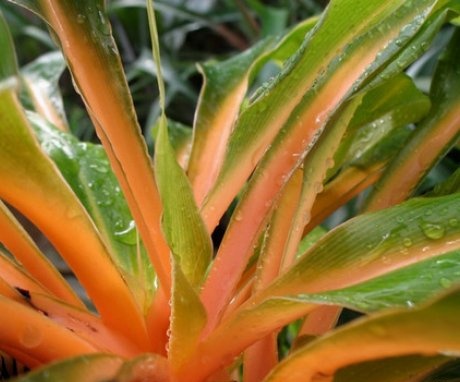How to properly grow Green Orange chlorophytum?
Many gardeners not only breed flowering plants, but also cultivate exotic plants of an evergreen nature. One of these original bushes is Green Orange chlorophytum. He is endowed with a specific color and demanding care. When growing it, you should know the main points of care and maintenance rules.
Content:
- What does a houseplant look like?
- Breeding methods and planting
- How to properly care for chlorophytum?
- What conditions are needed for normal growth?
- Everything you need to know about a transplant
- The consequences of improper care
- Diseases and pests, the fight against them
What does a houseplant look like?
One of the names of Green Orange chlorophytum is winged. It differs significantly from other representatives of its species, not only by the name or color of the stems, but also by the filing of leaf plates and the whole appearance.
Description and structural features of the plant:
- The peculiarity of this flower is that its cuttings, extending from the central rosette, have an unusual orange hue, smoothly turning into a rich green tone of the leaf plates. The petioles themselves are much longer than those of other varieties of this species.
- The plant is not significant in height and reaches 30-35 cm.
- The shrub has no central stem. All its leaves grow straight from the outlet.
- The foliage has lanceolate plates, wide in size. Departing from the base, they expand, and towards the end they narrow. The length can vary from 6 cm to 10-12 cm, depending on the conditions in which the plant is located.
- The surface of the leaf is fleshy, leathery, gives a sparkling shine, glossy. It is recommended to spray the shrub periodically in order to moisten the surface of the foliage and wipe off adhering dust from the shiny leaves. With a significant amount of light, an orange border appears at the edges of the leaf plate, beautifully completing the leaf.
- The plant periodically produces small stalks in size and growth. The inflorescences are arranged on the cob in a spiral manner. The flowers do not stand out in bright colors, but are white in color. Flowering is short, faded. Therefore, chlorophytum orange is valued exclusively as an evergreen ornamental plant.
- Root system the plant has both branched rhizomes and small nodules, oblong in size, light tone. The latter are located on the main rhizomes in an insignificant amount.
Due to its peculiar appearance, the shrub is very popular and recognized among experienced gardeners and beginners. If the standard plant species are unpretentious, then when growing Chlorophytum orange, you will have to apply some effort and constantly take care of the shrub.
Breeding methods and planting
The main difference between Green Orange chlorophytum and standard varieties is the absence of whiskers extending in different directions. The plant reproduces in slightly different ways.
Obtaining new original copies of orange chlorophytum is carried out by the following methods: seed material, dividing the shrub, layering.
To get an original plant with maternal inclinations, you must correctly collect fully ripe seeds from a shrub. Or use an easier way - buy in a specialized store, in the original packaging. It is not worth buying planting material from your hands, a completely different variety may grow that does not possess the original qualities of Green Orange chlorophytum.
- To carry out proper rooting of seeds, they should be soaked in a wet cloth for 24 hours, while placing a saucer with soaked seeds in a warm room.
- Planting is recommended in the first months of spring. For rooting, you should prepare pots filled with peat and river sand, fine fraction, filled in equal parts.
- During planting, remove the top layer of soil and scatter all seedlings. On top it is worth pouring the prepared substrate no more than 5-7 mm. If the seedlings are placed much deeper, then the germinating sprouts can rot and never see the sunlight.
- After planting, it is necessary to irrigate the leveled surface well with moisture from a spray bottle. It is forbidden to use watering by other methods, it can wash the seedlings or, conversely, deeply deepen them. From above, the flowerpot is covered with a film.
- An impromptu greenhouse is installed in a warm, bright room in which the temperature does not drop below +22 C. It is imperative to carry out daily ventilation and spraying as the soil dries out.
- The first timid shoots in most cases begin to sprout at the same time. The process takes place no earlier than 4 weeks after planting. Films are not removed immediately during germination of seedlings; seedlings should be gradually accustomed to open air. When 2-3 full-fledged leaves appear, new plants can be transplanted to a new place of residence.
Due to the lack of air whiskers in orange chlorophytum, its reproduction occurs by separating daughter rosettes. They form as the shrub grows. Optimal conditions for growth favorably affect the receipt of daughter outlets, which quickly fill the entire space of the flowerpot, forming a chic overgrown bush.
Separation of a young plant should be done carefully with a garden knife.
The plant is gently pushed on so as not to injure the rhizomes and is gradually pulled to the surface. The seedling is separated from the mother bush, cutting off as much of the rhizomes as possible. After that, it takes root in a new place.
To obtain a young seedling, you can resort to dividing the mother shrub. Once every 4 years, it is recommended to carry out such a procedure, which allows you to disconnect the growing daughter sockets. For this, the shrub is completely taken from its place of residence. To do this, you should first slightly irrigate the soil. The plant should be divided into several parts, but make sure that each part has enough roots and buds for growth. The planting process itself is not very different from the planting method of another type of chlorophytum.
How to properly care for chlorophytum?
In order for the plant to grow well and develop qualitatively, the most favorable conditions should be provided to the shrub. If we remember that chlorophytum prefers to grow on the banks of rivers and lakes, then its watering should be saturated, abundant.
Watering rules:
- In summer, it is recommended to thoroughly water the soil near the shrub. This procedure should be carried out no more than 2 times a week.
- In winter, it is advisable to reduce irrigation to once every 7 days. For irrigation, it is advisable to use settled water at room temperature.
- If you water the bush with cold tap water, you can freeze the root system if the procedure takes place in winter, and in summer salt deposits will appear on the ground in the form of a white bloom. This indicates an increased hardness of the water, which can negatively affect the general condition of the plant.
- Watering should be along the edges of the flowerpot in which the orange chlorophytum lives. When moisture gets on the central part, it settles in the opening of the cuttings attachment to the outlet and causes the leaves to rot.
- It is imperative to control the volume of water, it is not worth overfilling the shrub, moisture should saturate the plant, but not turn the soil into swampy soil. Otherwise, stagnant water can provoke the development of root rot or other fungal diseases.
The plant responds positively to feeding. In order to maintain the necessary brightness of the cuttings, additional nutrients of a complex nature should be added. But the dosage should be reduced by 2 times.
It is recommended to add iron ("Iron Chelate" or "Ferrovit") to the water for irrigation once every 4 weeks.
In order for the shrub to stand out for its original orange hue, it is recommended to remove the plant from direct sunlight, supplying only diffused light, remove young shoots that form on the sides of the mother plant and eliminate flower stalks. All these points reduce the strength of the exotic and reduce its color.
What conditions are needed for normal growth?
Some conditions provide normal growth. If they are performed, then chlorophytum grows into a chic shrub with bright leaf plates.
The following rules should be followed when caring for a plant:
- Lighting - hitting the flower of the sun's rays should not be detrimental to the flower. The bush has a beneficial attitude to the rays of the luminary, but it is recommended to shade the shrub in the summer afternoon. Also, the flower will burn well in the semi-darkness, but then all its original color disappears. In summer, you should not hide an exotic guest in the far corner, it is better to take him out into the fresh air and, if conditions permit, set him under the canopy of trees.
- Temperature - chlorophytum is a heat-loving plant, for which the optimal growing temperature is +25 .. + 27 C. In winter, this temperature is reduced to +20 .. + 22 C. Sometimes it is possible to lower the degrees to +15 C, but such a jump in temperature the regime should not be left for a long period of time. A short abstinence is only beneficial, and prolonged exposure to cool conditions significantly reduces the plant's immunity.
- Placement - it is recommended to find the optimal location for the flower so that it is comfortable enough while sitting in one place. If there is a draft of cold air on the selected windowsill, then the exotic can react negatively or get sick.
- Humidity - Chlorophytum Green Orange does not need special humidity, you can, if desired, spray the shrub from a spray bottle in the summer heat. But it is worth holding the event so that during the procedure the plant is not in direct sunlight - it can provoke the appearance of burns.
The most important condition for the normal development of a flower is lighting. Orange chlorophytum should be monitored. This is due to the fact that if a bush stands in direct sunlight for a long period of time, it can not only get burned, but its color can turn white. Otherwise, prolonged darkening also negatively affects the tone of the cuttings and the edging - they cease to be orange.
Everything you need to know about a transplant
Each young plant must be replanted annually. Starting from the age of 5, the frequency of transplanting a bush should be reduced and the procedure should be carried out once every 3 years. It is better to plan the event at the end of February - the first ten days of March.
Exot has a well-developed system that quickly fills the entire space of the flowerpot. Therefore, when transplanting, it is necessary to pick up a container several centimeters larger in diameter than the previous flowerpot. An overly deep and spacious container should not be used. This is due to the fact that until the plant completely fills the empty space with rhizomes, the ground part will not develop.
Before starting the transplant, you should prepare the soil. The soil substrate consists of a certain set of components necessary for the comfortable life of an exotic pet. The following ingredients stand out:
- Leafy soil.
- Humus from fallen leaves.
- Chopped pine bark.
- River sand, fine fraction.
- Sod soil.
All components, with the exception of sod soil, should be taken in 1 part and only the last ingredient is taken in 2 parts. Everything is thoroughly mixed. Expanded clay is immediately placed on the bottom of the selected flowerpot. It can be replaced with styrofoam, sea pebbles, or pieces of broken red brick. Then the soil mixture is poured to the middle of the flowerpot.
The transplanted shrub is freed from the old substrate to the maximum and set on the ground in a new pot. Before placing the orange chlorophytum in the flowerpot, it is necessary to inspect its rhizomes. If rotten or damaged areas are found, they are carefully removed and disinfected in a weak solution of potassium permanganate.
After the procedure, the bush is installed in the center of the flowerpot and covered with new soil from above. Care must be taken to ensure that no hollow spaces remain in the soil. If they are formed, then moisture can stagnate in them and provoke the development of pathogenic bacteria.
The soil for planting is selected well-conductive not only air, but also moisture.
Necessarily need to control soil acidity, slightly acidic earth or neutral is perfect. It should be in the range of 6.8-7.2 pH. If transplanting is carried out annually, then fertilizers can not be applied in large quantities. Fresh nutritious earth will provide all the essential minerals and vitamins needed to maintain the vibrant color of Chlorophytum Green Orange.
The consequences of improper care
If you carry out constant care for orange chlorophytum, then the exotic is not exposed to diseases and pests. Otherwise, improper cultivation provokes the emergence of certain difficulties:
- At the ends of the deciduous plates, yellow or brown stripes are formed. This process is characterized by insufficient nutrition with useful elements; it is required to feed the plant with fertilizers.
- The leaf plate is covered with brown or black spots along the entire perimeter of the leaf - frequent overflow of water is carried out. It should not water the bush for a certain period of time, allow the soil to dry completely and only then begin to apply the volumes of water normally.
- The stems have lost their original color - the plant is in a darkened place, it should be moved to a windowsill with sufficient sunlight.
- The foliage has stopped growing, there has been no flowering for a long time - the flower has completely braided the soil contained in the flowerpot, it is necessary transfer.
- Deciduous plates began to curl and fall off - the permissible lower humidity threshold in the room where the exotic flower is located is exceeded. It is necessary to additionally spray the bushes or install a pallet next to it, into which the pebbles filled with water are placed.
- The leaves of the foliage are covered with black, yellow or brown spots - rotting of the root system may occur due to excessive watering and strong soil moisture. It is required to pull the plant out of the soil, remove rotten areas, disinfect in a weak solution of potassium permanganate. After all the manipulations, place in a new pot and fresh soil.
If any signs of plant malaise are found, the bush should be examined and the possible cause of the problem should be determined. When the first signs are found, you should immediately make an effort and try to heal the plant.Otherwise, there is a possibility of bringing the bush to a state from which there is no way to cure.
Diseases and pests, the fight against them
Most often, a completely healthy plant is not damaged by pests. The parasite can join the weakened plant. Usually, parasitic insects that feed on sap are individuals:
- Spider mite - cobwebs entwine the leaves and stems of the bush.
- Aphid - provoke curling of leaves into a tube.
- Mealybugs - when they appear, the foliage begins to fall off the bush.
- Scabbards - sticky spots and small growths of a yellow tint appear on the deciduous cover.
If small quantities of parasites are found, the pests are removed manually. In other situations, a solution of green or laundry soap is used. It is better to remove heavily damaged leaf plates. After completing these procedures, spray from a spray bottle or a special device with broths of tobacco, garlic or infusion of orange peels.
If all else fails and the plant continues to be invaded, it is worth resorting to spraying chemical insecticides.
Diseases appear only with improper care. In most cases, decay of the root system is detected. To eliminate it, it is necessary to adhere to the rules of watering and not flood the soil, monitor the amount of water introduced.
Thus, Chlorophytum Green Orange is a plant that has its own specific requirements. It grows and grows well in certain conditions, but with inadequate care it quickly begins to hurt and loses its original appearance. In order not to provoke the development of the pest population, the general condition of the plant should be monitored.
More information can be found in the video:



